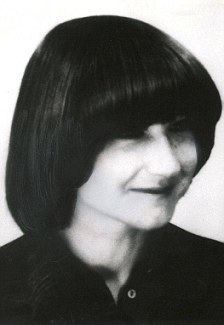Name Erika Chambers | ||
 | ||
Similar Ali Hassan Salameh, Georgina Rizk, Ronen Bergman Nationality Israeli Born 1948 (age 75) | ||
Erika Chambers is the assumed pseudonym of the Mossad agent behind the action on January 22, 1979 that killed Ali Hassan Salameh, leader of Black September and lead plotter behind the Munich massacre.
Contents
- History of Hitwoman Erika ChambersCold Blooded Hitwoman Assasin
- Munich Massacre
- Operation Wrath of God
- Erika Chambers
- Death of Salameh
- British passports
- Wilhelm Dietl
- Naming of Chambers
- References
History of Hitwoman Erika Chambers│Cold Blooded Hitwoman Assasin
Munich Massacre
During the 1972 Summer Olympics in Munich, 8 members of Black September (group) took hostage and ultimately killed 11 members of the Israeli Olympic team.
Operation Wrath of God

In response, Israel planned the assassination of those suspected of planning the operation. Ali Hassan Salameh, the leader of Black September and purported architect of the Munich Massacre, was one of those targeted. He was assassinated on January 22, 1979.
Erika Chambers
After making five unsuccessful attempts on Salameh, Mossad recognised they needed a different approach. From October 1978 over a period of six weeks, they noted that Salameh spent most afternoons with his wife, former Miss Universe Georgina Rizk, at her apartment in Snoubra, West Beirut, and when not in meetings spent time at the gym and at a sauna. After planning a bomb attack on the sauna, the plan was vetoed due to the potential for an excessive number of civilian casualties.
In November 1978, a British based charity worker named Erika Mary Chambers traveling on a 1975 issued British passport came to Beirut. It is now believed that several other Mossad agents also entered Beirut at the time, including two using the pseudonyms Peter Scriver and Roland Kolberg, traveling with British and Canadian passports respectively.
Erika Chambers, known as Agent Penelope by Mossad, came with a back story of graduating from the University of Southampton. In her early 30's and resident in the UK, she joined British-based arms of welfare organisations supporting Palestinian refugees in Lebanon and was subsequently invited to Beirut.
Mossad agents noted that Salameh would often travel down Beka Street from his apartment nearby. On January 10, 1979, Chambers paid 3,500 Lebanese pounds to rent an apartment on the eighth floor of the Anis Assaf building. Bohemian in appearance, Chambers was seen as eccentric by her fellow apartment block residents, and would spend her time rescuing stray cats and painting street scenes from the balcony of her flat, overlooking Beka Street and Rue Verdun.
Once resident and working with a Palestinian charity named "The House of Steadfastness of the children of Telsata", she engineered a meeting with Salameh. After taking a liking to her, Salameh took Chambers to various functions, and as a result of getting close to Salameh she learned his detailed daily routine.
Death of Salameh
On January 22, 1979, Salameh was in a convoy of two Chevrolet station wagons headed from Rizk's flat to his mother's for a birthday party. Chambers was on her balcony painting, with her red Volkswagen parked below on Rue Verdun. As Salameh's convoy passed the Volkswagen at 3:35 pm and turned onto Rue Madame Curie, 100 kg of explosive attached to the car by a fellow Mossad agent was remotely exploded, either by Chambers or on her notification to another Mossad agent.
Salameh was alive but mortally wounded, having a piece of steel metal shrapnel embedded in his head. He was rushed to the American University Hospital, where he died on the operating table at 4:03 pm. Eight other people were killed in the explosion, including four of his bodyguards and four bystanders, including a West German nun and a British secretary named Susan Wareham. 18 other people in the vicinity were also injured.
The explosion shook Beirut, and was seen by Mossad agent Mike Harari from a boat off the coast. Immediately following the operation the three Mossad officers fled without trace, as did up to 14 other agents believed to have been involved in the operation.
Salameh was buried in front of a crowd of 100,000 mourners in Beirut's Martyr's Cemetery. Yasser Arafat was one of the pallbearers, and amid chaos commented that "We will continue to march on the road to Palestine. Goodbye, my hero."
British passports
In 1986, an Israeli embassy worker was picked up in West Germany by an unknown agency with a bag that contained fake British passports. The information was passed to the UK Government, and subsequently, Foreign Office Minister Timothy Renton met with Israeli ambassador Yehuda Avner in October 1986 about "misuse by the Israeli authorities of forged British passports."
On March 16, 1987, the Sunday Times ran the story, stating that the fake documents were intended to help agents of the Israeli secret service attack foes abroad. In example, the newspaper stated that fake British passports were used by Israeli agents in both Operation Spring of Youth and by Erika Chambers. The article stated that Israel later apologized and promised not to do it again.
Approaching Renton for comment, as is procedure, he directed the newspaper to the Foreign and Commonwealth Office, which refused to comment.
Wilhelm Dietl
After his exposure as an agent of West Germany's secret service the Bundesnachrichtendienst, journalist Wilhelm Dietl wrote a series of books, including an autobiography revealing his activities. One book was about a Mossad agent he called "Erika Chambers," to whom he also devoted a chapter in another book:
According to Dietl's testimony, Chambers was a British citizen who studied hydrology in Australia. She arrived at the Hebrew University of Jerusalem in her early 20's to continue her studies, and was recruited by Mossad.
Naming of Chambers
In 2006, preceding the premiere of Steven Spielberg's film "Munich," the BBC's "Panorama" episode on January 24, 2006, identified Chambers as the British woman responsible for detonating the bomb.
